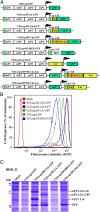Enhancement of protein expression by alphavirus replicons by designing self-replicating subgenomic RNAs
- PMID: 25002490
- PMCID: PMC4115546
- DOI: 10.1073/pnas.1408677111
Enhancement of protein expression by alphavirus replicons by designing self-replicating subgenomic RNAs
Abstract
Since the development of infectious cDNA clones of viral RNA genomes and the means of delivery of the in vitro-synthesized RNA into cells, alphaviruses have become an attractive system for expression of heterologous genetic information. Alphaviruses replicate exclusively in the cytoplasm, and their genetic material cannot recombine with cellular DNA. Alphavirus genome-based, self-replicating RNAs (replicons) are widely used vectors for expression of heterologous proteins. Their current design relies on replacement of structural genes, encoded by subgenomic RNAs (SG RNA), with heterologous sequences of interest. The SG RNA is transcribed from a promoter located in the alphavirus-specific RNA replication intermediate and is not further amplified. In this study, we have applied the accumulated knowledge of the mechanism of alphavirus replication and promoter structures, in particular, to increase the expression level of heterologous proteins from Venezuelan equine encephalitis virus (VEEV)-based replicons. During VEEV infection, replication enzymes are produced in excess to RNA replication intermediates, and a large fraction of them are not involved in RNA synthesis. The newly designed constructs encode SG RNAs, which are not only transcribed from the SG promoter, but are additionally amplified by the previously underused VEEV replication enzymes. These replicons produce SG RNAs and encoded proteins of interest 10- to 50-fold more efficiently than those using a traditional design. A modified replicon encoding West Nile virus (WNV) premembrane and envelope proteins efficiently produced subviral particles and, after a single immunization, elicited high titers of neutralizing antibodies, which protected mice from lethal challenge with WNV.
Keywords: expression vectors; vaccines.
Conflict of interest statement
The authors declare no conflict of interest.
Figures






References
-
- Griffin DE. Alphaviruses. In: Knipe DM, Howley PM, editors. Fields' Virology. 4th Ed. New York: Lippincott, Williams and Wilkins; 2001. pp. 917–962.
-
- Weaver SC, Frolov I. Togaviruses. In: Mahy BWJ, Meulen VT, editors. Virology. Vol 2. Salisbury, UK: ASM Press; 2005. pp. 1010–1024.
-
- Strauss EG, Strauss JH. Structure and replication of the alphavirus genome. In: Schlesinger S, Schlesinger MJ, editors. The Togaviridae and Flaviviridae, The Viruses. New York: Plenum; 1986. pp. 35–90.
Publication types
MeSH terms
Substances
Grants and funding
LinkOut - more resources
Full Text Sources
Other Literature Sources

